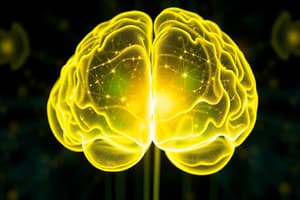Podcast
Questions and Answers
What does vigilance refer to in the context of attention?
What does vigilance refer to in the context of attention?
- The ability to ignore distractions entirely.
- The ability to recognize familiar stimuli quickly.
- The ability to switch attention rapidly between tasks.
- The ability to attend to a field of stimulation over a prolonged period. (correct)
Which term describes the process of selecting certain stimuli to focus on while ignoring others?
Which term describes the process of selecting certain stimuli to focus on while ignoring others?
- Selective Attention (correct)
- Signal Detection
- Vigilance
- Divided Attention
How does divided attention function in terms of task performance?
How does divided attention function in terms of task performance?
- By increasing the ability to detect non-target stimuli.
- By eliminating the need for multitasking.
- By allocating attentional resources to manage multiple tasks. (correct)
- By enhancing focus on a single task.
What is the purpose of the shadowing task developed by Cherry?
What is the purpose of the shadowing task developed by Cherry?
What does the Attenuation Model proposed by Anne Treisman suggest?
What does the Attenuation Model proposed by Anne Treisman suggest?
Which of the following best describes Signal Detection Theory?
Which of the following best describes Signal Detection Theory?
What are the four possible outcomes when detecting a target stimulus?
What are the four possible outcomes when detecting a target stimulus?
What does the Cocktail Party Effect exemplify?
What does the Cocktail Party Effect exemplify?
Which statement about distractors is accurate?
Which statement about distractors is accurate?
Which of the following correctly describes a 'Hit' in attention theory?
Which of the following correctly describes a 'Hit' in attention theory?
What could be considered a common factor that influences our ability to pay attention?
What could be considered a common factor that influences our ability to pay attention?
Which situation represents a 'False Alarm' in signal detection?
Which situation represents a 'False Alarm' in signal detection?
What is indicated by 'Miss' in the context of attention?
What is indicated by 'Miss' in the context of attention?
How does attention primarily function according to the discussed outcomes?
How does attention primarily function according to the discussed outcomes?
Which describes a 'Correct Rejection' outcome in attention?
Which describes a 'Correct Rejection' outcome in attention?
In the context of signal detection, what does the term 'Vigilance' refer to?
In the context of signal detection, what does the term 'Vigilance' refer to?
What is the primary function of the attentional filter in Broadbent's model?
What is the primary function of the attentional filter in Broadbent's model?
In the late-filter model proposed by Deutsch and Deutsch, when are stimuli filtered?
In the late-filter model proposed by Deutsch and Deutsch, when are stimuli filtered?
What does divided attention refer to?
What does divided attention refer to?
Which model suggests that stimuli pass through the filter right after sensory detection?
Which model suggests that stimuli pass through the filter right after sensory detection?
Which factor is NOT mentioned as influencing our ability to pay attention?
Which factor is NOT mentioned as influencing our ability to pay attention?
What happens to stimuli that are filtered out according to Broadbent’s model?
What happens to stimuli that are filtered out according to Broadbent’s model?
How does the bottleneck model describe information processing?
How does the bottleneck model describe information processing?
What is one characteristic used to distinguish multiple sensory channels in Broadbent's model?
What is one characteristic used to distinguish multiple sensory channels in Broadbent's model?
Which area of the brain is primarily implicated in unilateral lesions that cause visual field neglect?
Which area of the brain is primarily implicated in unilateral lesions that cause visual field neglect?
What is a common symptom of children with the inattentive type of ADHD?
What is a common symptom of children with the inattentive type of ADHD?
Which process involves tasks executed without constant human involvement?
Which process involves tasks executed without constant human involvement?
Which of the following factors is NOT associated with ADHD?
Which of the following factors is NOT associated with ADHD?
What does change blindness refer to?
What does change blindness refer to?
What is primarily affected by differences in dopamine regulation in children with ADHD?
What is primarily affected by differences in dopamine regulation in children with ADHD?
Which of the following characteristics is associated with controlled processing?
Which of the following characteristics is associated with controlled processing?
Which symptom reflects a common challenge faced by children with ADHD concerning task management?
Which symptom reflects a common challenge faced by children with ADHD concerning task management?
Flashcards are hidden until you start studying
Study Notes
Attention
- Mechanism for actively processing limited information from vast sensory input and cognitive processes.
- Outcomes when detecting target stimuli: hits, false alarms, misses, correct rejections.
Four Main Functions of Attention
- Signal Detection and Vigilance: Focus on identifying specific stimuli amidst distractions.
- Search: Engaging actively in looking for particular stimuli.
- Selective Attention: Choosing specific stimuli to focus on while ignoring others.
- Divided Attention: Managing multiple tasks simultaneously by allocating attentional resources efficiently.
Signal Detection Theory
- Framework explaining how people identify important stimuli from distractions.
Selective Attention
- Cocktail Party Effect: Focusing on one conversation amid several others.
- Shadowing: Listening to and processing two different messages simultaneously via dichotic presentation.
Theories of Selective Attention
- Attenuation Model (Anne Treisman): Suggests weak filtering of non-target stimuli rather than complete blockage, allowing some unattended information analysis.
- Broadbent's Model: Early filtering at sensory input level based on physical properties (e.g., loudness, pitch) before reaching perception.
- Late-Filter Model (Deutsch and Deutsch): Filters stimuli after analysis of both physical properties and meaning, allowing additional processing before selection.
Factors Influencing Attention
- Anxiety: Can decrease attention span and focus.
- Arousal: Levels of alertness affect attentional capacity.
- Task Difficulty: More complex tasks demand greater focus and resources.
- Skill: Higher proficiency can improve attention management.
Spatial Neglect
- Attentional dysfunction resulting in ignoring half of the visual field opposite the brain hemisphere with damage (common in right hemisphere lesions).
Attention-Deficit/Hyperactivity Disorder (ADHD)
- Factors contributing to ADHD: maternal substance use during pregnancy, lead exposure, brain injury, food additives, dopamine regulation disparities.
- Symptoms in inattentive ADHD type: easily distracted, careless mistakes, incomplete task completion, and tendency to misplace necessary items.
Automatic and Controlled Processes
- Automatic Processing: Task performance without conscious involvement, using predefined rules or algorithms.
- Controlled Processing: Conscious and intentional cognitive activities requiring focused attention.
Change Blindness
- Inability to notice changes in objects or scenes being observed, highlighting limitations in visual attention.
Studying That Suits You
Use AI to generate personalized quizzes and flashcards to suit your learning preferences.




